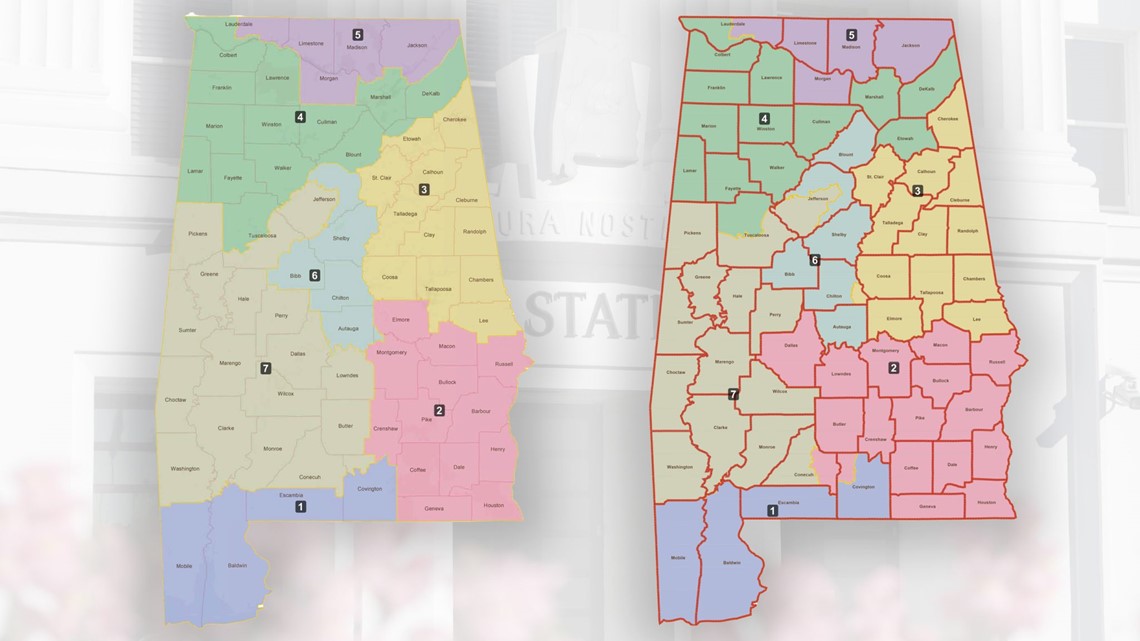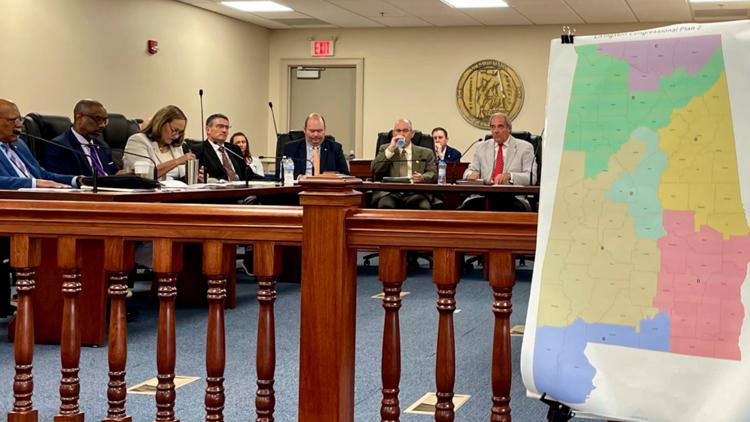MONTGOMERY, Ala. — On the eve of a court deadline, Alabama lawmakers are still divided Thursday over the map designating new congressional districts and sparred over what constitutes an “opportunity” district that the state was ordered to create for Black voters.
Republican-controlled committees in the House of Representatives and Senate continue to advance separate plans that increase the number of Black voters in the state’s 2nd congressional district but fail to establish the second majority-Black district, as sought by plaintiffs who won the Supreme Court case last month.
Under the state Senate plan, the number of Black voters in the 2nd congressional district would increase from about 30% to 38%; under the House plan, it would increase to 42%.
“We believe it does meet the Voting Rights (Act) standard because we followed all the guidelines. As an opportunity district, nobody knows what the definition of opportunity is. They didn’t give us (a definition),” Sen. Steve Livingston said. The Republican senator from Scottsboro said the chamber settled on 38% of the population of Black voters as adequate to fulfill the court’s directive.
“So I’ve got an opportunity to lose,” said Senate Minority Leader Bobby Singleton, a Democrat from Greensboro.
Black lawmakers argued those numbers would make it impossible for a Black candidate to win in that district, and do not comply with the court directive to create a second majority-Black district “or something quite close to it.”
“There ain’t no way that in that district — that we’re dealing with here in two — that an African-American got a chance to get elected. Ain’t no way whatsoever,” said Democratic Sen. Rodger Smitherman of Birmingham.


The House and Senate passed two different maps on Wednesday, but it might end up that neither becomes the map that gains final passage from the Legislature.
Sen. Dan Livingston, R-Scottsboro, said he expected work would begin on a new map Thursday as a compromise between the Republicans in the separate chambers.
“I don’t think it will be proposed tomorrow, but I think there will be a new map worked on tomorrow I would expect, yes,” Livingston said.
Both maps passed Wednesday include only one majority-minority district, actually weakening the Black voting power in Rep. Terri Sewell’s District 7. House Reapportionment Chair Chris Pringle’s plan would bring the Black voting age population (BVAP) in District 2 to 42 percent. The Livingston plan would only bring BVAP to 38 percent.
Democrats have criticized both maps, arguing that neither meets the court’s order to create a second majority-minority district “or something quite close to it.”
During four hours of debate on the map Wednesday, Pringle relied on arguments that have already been rejected by the courts, including an insistence on keeping Mobile and Baldwin counties together as a community of interest.
Rep. Napoleon Bracy, D-Prichard, illustrated that the VRA remedial plan proposed by the plaintiffs in Allen v. Milligan more accurately divides Mobile into separate communities of interest.
Bracy pointed to racial and income disparity within the counties.
“The math ain’t mathin’” Bracy said. “It doesn’t add up when you look at extremely high Black population in these areas and then extremely high White population in these areas and then we say these re communities of interest; they are absolutely not.”
Orange Beach, which is in Baldwin County, is 98 percent white, Bracy said. Meanwhile Prichard in Mobile County is 91 percent Black. There is also a high disparity in household median income. The median household income in Baldwin County is more than $61,000. Mobile County is closer to $41,000 and communities like Prichard are around $30,000.
The VRA remedial plan still keeps the Gulf coast together as a community of interest, but brings the northern part of Mobile county into the Black Belt.
Multiple Democrats talked about the history of families in northern Mobile County that migrated from the more traditional Black Belt.
Democrats have also taken issue with the process.
DAY OF RECKONING
With a Friday deadline imposed by the federal court, a compromise map will have to be introduced as an amendment or substitute in one of the chambers as a new bill can not make it through the legislative process in two days. Alternatively, the map could come out of a conference committee.
State lawmakers face a Friday deadline to adopt new lines after the U.S. Supreme Court in June upheld a three-judge panel’s finding that the current state map — with one majority-Black district out of seven in a state that is 27% Black — likely violates the federal Voting Rights Act.
State republicans, who have been reluctant to create a Democratic-leaning district, are engaging in a high-stakes wager that the panel will accept their proposal, arguing that the compact scale of the districts satisfy redistricting principles, or that the state will prevail in a second round of appeals.
The panel that issued a preliminary injunction blocking use of the existing map said in 2022 that Alabama should have “either an additional majority-Black congressional district, or an additional district in which Black voters otherwise have an opportunity to elect a representative of their choice.” The judges added that any map should include two districts where “Black voters either comprise a voting-age majority or something quite close to it.”
The meaning of the terms "quite close" and “opportunity” have dominated much of the legislative debate.
“We’ve got information that’s come from the court. We’ve had information come from the justices, but much of this is speculative as to what they meant,” Senate President Pro Tem Greg Reed, the Republican leader of the Senate, told reporters Thursday.
Reed said lawmakers are working toward a compromise between the state House and Senate plans, and that the lawmakers will “absolutely” meet the Friday deadline.
Once a new GOP map is approved, the fight will shift quickly back to the courts. A Democratic state senator speculated that Alabama Republicans are seeking another Voting Rights Act challenge before the U.S. Supreme Court.
“I think the (Alabama) attorney general is setting up a war with Section 2 (of the Voting Rights Act) so once they get back they can have a real shot at gutting Section 2. That's just my gut,” Singleton said.
Plaintiffs who won the Supreme Court case have said they will challenge either proposal if enacted.
Scott Douglas, executive director of Greater Birmingham Ministries and a plaintiff in the case, said lawmakers have “apparently learned nothing from their loss at the Supreme Court, the Legislature has put forward yet another map that dilutes the electoral power of Black Alabamians.”
—-
Associated Press writer Jeff Amy contributed. A portion of this article originally appeared on ALReporter.com.



